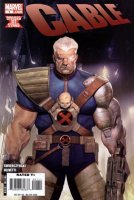Chapter 8: X-Men Disassembled
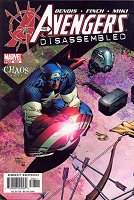 In August of 2005, a new event rocked the world of the X-Men. During Brian Michael Bendis’ recent 2004 Avengers Disassembled storyline, which ran from Avengers (1st series) #500-503, it had been revealed that the Scarlet Witch’s reality altering powers had been causing chaos for some time, perhaps years. The story came to a head in the final issues of Excalibur (3rd series), when Magneto rescued Wanda from capture and brought her to Genosha.
In August of 2005, a new event rocked the world of the X-Men. During Brian Michael Bendis’ recent 2004 Avengers Disassembled storyline, which ran from Avengers (1st series) #500-503, it had been revealed that the Scarlet Witch’s reality altering powers had been causing chaos for some time, perhaps years. The story came to a head in the final issues of Excalibur (3rd series), when Magneto rescued Wanda from capture and brought her to Genosha.
It did not take the heroes long to discover the Witch’s whereabouts and, at the beginning of the 8-issue House of M miniseries, the Avengers and X-Men journeyed to Genosha to end her threat forever. Realizing that they meant to do her harm, Quicksilver manipulated his sister into altering the entire world, reshaping a reality where mutants were the majority and ruled the world under the leadership of their benevolent monarch, Magneto. 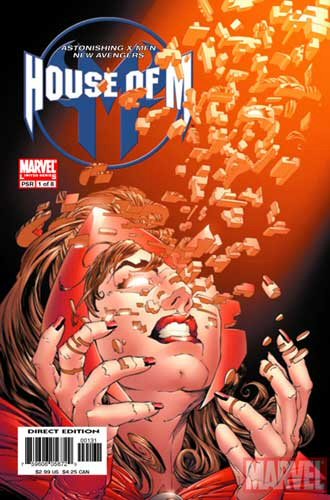 Still, events conspired to bring down the House of M, as more and more heroes were brought out of the fantasy Wanda had created. When they eventually confronted her, Wanda restored reality to normal, with one exception. Using her powers, she eliminated the mutant X-factor gene in over 90% of the mutants on the planet, making being a mutant a rare thing once again.
Still, events conspired to bring down the House of M, as more and more heroes were brought out of the fantasy Wanda had created. When they eventually confronted her, Wanda restored reality to normal, with one exception. Using her powers, she eliminated the mutant X-factor gene in over 90% of the mutants on the planet, making being a mutant a rare thing once again.
The House of M storyline took place not only in the 8-issues miniseries, which ran from August to December of 2005, but in many titles across Marvel's line. Nearly every Marvel series at the time had one or more issues set in the House of M reality. However, post House of M, the results of the mutant depopulation, quickly named “M-Day” or “the Decimation,” mainly affected the X-titles. While each of the existing mutant titles addressed the change in the mutant population, they did so in very different ways. The most notable exception being Polaris, most of the mainstay X-characters remained with their powers intact, and they devoted themselves to helping the few mutants left against a rise of anti-mutant groups who were trying to take advantage of their targets diminished numbers.
However, in contrast to this, in New X-Men (2nd series) the effects of M-Day were felt much closer to home. As the title’s mandate was to tell the adventures of a new and larger generation of mutants, the school’s population was most heavily stricken by the Decimation, leaving only a handful of students with powers. Starting with #20, Emma Frost would use this opportunity to draft the “New X-Men” from the ashes of the school.
Another immediate and almost surreal ramification to the Decimation was the introduction of the US government’s Office of National Emergency (nicknamed O*N*E), which sent Sentinels to ostensibly “guard” the X-Men and the few remaining mutants in the world, as a type of mutant “endangered species” protection program. Rather than being robots, these Sentinels were actually piloted by human beings, many of whom did not care for mutants at all. While supposedly helping to protect the X-Men and the other mutants which came to the mansion looking for sanctuary (as seen in the X-Men: 198 miniseries), the Sentinels acted as prison guards, enforcing a mutant “ghetto” and repeatedly refusing any of the mutants the right to leave – for their own protection.
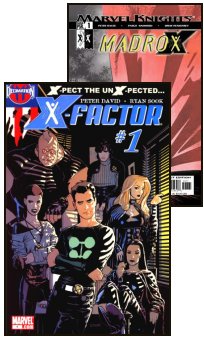 Another title which began the same month was a new X-Factor, written by previous X-Factor scribe Peter David. A little over a year earlier, between late 2004 & early 2005, Peter David had written a five-issue miniseries called Madrox, which reintroduced the character of Jamie Madrox, now as a detective in Mutant Town. Along with his friends, Strong Guy and Wolfsbane, Madrox opened X-Factor Investigations in the final issue, giving fans of David’s early X-Factor run a hope that he would begin the series anew. In January 2006, fans got their wish with the launch of the new title, in which they were joined by Siryn, the now-depowered Rictor and the enigmatic Layla Miller, who had played a crucial role in the House of M crossover.
Another title which began the same month was a new X-Factor, written by previous X-Factor scribe Peter David. A little over a year earlier, between late 2004 & early 2005, Peter David had written a five-issue miniseries called Madrox, which reintroduced the character of Jamie Madrox, now as a detective in Mutant Town. Along with his friends, Strong Guy and Wolfsbane, Madrox opened X-Factor Investigations in the final issue, giving fans of David’s early X-Factor run a hope that he would begin the series anew. In January 2006, fans got their wish with the launch of the new title, in which they were joined by Siryn, the now-depowered Rictor and the enigmatic Layla Miller, who had played a crucial role in the House of M crossover.
However, while X-Factor had been based in Mutant Town, in the wake of the Decimation such a place no longer existed. Now post M-Day, the group had the dual mission of working for their clients and acting as advocates for the former mutants who still resided in what was once Mutant Town. This 3rd X-Factor series ran for 50 issues, after which it received a new numbering system. Ignoring the 4 issues of the 2002 miniseries of the same name, the 50 issues of the 3rd series was added to the 149 issues of the 1st series, and so X-Factor (3rd series) #50 was followed by X-Factor (1st series) #200. In this format, the title continued for many more years, ending with #262 in 2013. Even then, though, the title lived on via a re-launch with All-New X-Factor.
X-Factor was not the only series to find its genesis from the House of M event. In its aftermath, Wolverine received a new ongoing, called Wolverine Origin, not to be confused with the six-issue miniseries Wolverine: Origin, which was published in 2000. During the House of M miniseries, Wolverine’s memories had been restored, a phenomenon which stayed true once reality was restored. Now no longer with uncertainty regarding his past, Wolverine set upon a personal quest to confront what had been hidden from him.
True to the title's name, the series focused on aspects of Wolverine's past and previously hinted stories, such as Wolverine’s past animosities with Cyber, his history with Omega Red and his interaction with Captain America and Bucky during World War II. It also elaborated on Wolverine's membership with Team X and the mysterious Marumasa Blade. However, it also broke new ground with the revelation of Wolverine having a son named Daken and his connection with the Hudsons. Additionally, Origins further explored an idea introduced in a story in Wolverine’s main series, that an enigmatic being known only as Romulus seemed to have been involved in much of Wolverine’s past. All fifty issues of the series were written by Daniel Way, who had originally pitched the idea to Quesada as a five or six year story arc. The series was not so much cancelled as simply finished, when the originally proposed story can to a conclusion in 2010.
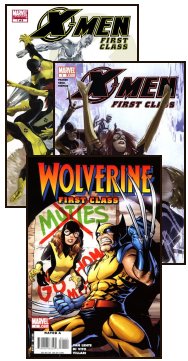 Later 2006 brought a new series to the X-Men, this one completely unrelated to the House of M or Decimation. It was a miniseries called X-Men: First Class, which would become popular enough to warrant its own ongoing series, followed by spin-off series. The concept of First Class would be to place stories in the first few years of the original X-Men’s time as students & heroes. According to Marvel, the stories were meant to be in continuity, however blatant inconsistencies such as differences in the characters’ costumes and odd changes such as Cerebro acting as a cybernetic teacher drew criticism from fans.
Later 2006 brought a new series to the X-Men, this one completely unrelated to the House of M or Decimation. It was a miniseries called X-Men: First Class, which would become popular enough to warrant its own ongoing series, followed by spin-off series. The concept of First Class would be to place stories in the first few years of the original X-Men’s time as students & heroes. According to Marvel, the stories were meant to be in continuity, however blatant inconsistencies such as differences in the characters’ costumes and odd changes such as Cerebro acting as a cybernetic teacher drew criticism from fans.
At the same time, other fans praised the light-hearted nature of the comic, as well as its use of stand-alone stories which could be enjoyed by all readers, new and old. The original miniseries ran for 8 issues from November 2006 to June 2007, after which the ongoing series ran from August 2007 until its cancelation with #16 in November 2008. To conclude this First Class series, a third series, this one a miniseries, was published in early 2009 under the name of X-Men: First Class Finals.
Though its ongoing series was canceled in 2008, by this time it had generated the spin-off series of Wolverine First Class, which debuted in May 2008. This new series dealt with the relationship between Wolverine and Kitty Pryde in the early months after her joining the X-Men. Interestingly, this series ran the longest of the all of the First Class franchise, with a total of 21 issues.
Yet another “First Class” series was the 3-issue miniseries Weapon X: First Class, which was launched in January 2009. Unlike earlier series, this title attempted to fit much more closely in with established continuity and was in many ways similar to Wolverine: Origins, except for the Weapon X program and characters. Late 2009 saw the last new series of the First Class titles, an 8-issue series called Uncanny X-Men: First Class that dealt with the "all-new, all-different" team that had debuted in Giant-Sized X-Men #1. There have been no more series of the First Class franchise since the cancelation of Wolverine: First Class in January 2010.
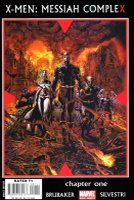 Ever since the end of the House of M and the Decimation event, the reduction in the number of mutants in the world had led many to believe that mutants were on their way to becoming extinct. This specific horror was addressed in the Beast-centered pseudo-crossover storyline called "Endangered Species," which ran as a back-up through all of the X-titles in mid to late 2007. Immediately thereafter, a full-fledged crossover called the "Messiah Complex" began, which would affect all titles in the X-world.
Ever since the end of the House of M and the Decimation event, the reduction in the number of mutants in the world had led many to believe that mutants were on their way to becoming extinct. This specific horror was addressed in the Beast-centered pseudo-crossover storyline called "Endangered Species," which ran as a back-up through all of the X-titles in mid to late 2007. Immediately thereafter, a full-fledged crossover called the "Messiah Complex" began, which would affect all titles in the X-world.
Beginning in December 2007 with a one-shot, a multi-faceted storyline weaved through four of the central X-titles. The story dealt with a race by various mutant and human groups to locate a newborn baby, which mutant-detecting sensors worldwide announced to be the first mutant birth since M-Day. Eventually, the child, a baby girl, was found and claimed by Cable, who had previously been believed to have been killed in the Cable/Deadpool ongoing series. He explained to the X-Men that, in his future timeline, the girl would grow up to be a messiah to mutantkind. However, Bishop disagreed, identifying the girl to be the source of all mutants’ problems in his. Being unable to tell which she would become, Cable sought to protect her to preserve his possible future, while Bishop wished to kill her in order to eliminate his.
The culmination of the story led to a confrontation between the X-Men and the Marauders, during which Cyclops gave the baby to Cable, believing he would protect the baby long enough for it to decide its own destiny. Though this decision ended the conflict behind the Messiah Complex storyline, it set into motion changes that would affect nearly every X-title.
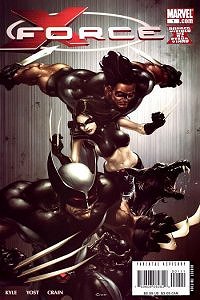 During the conflict, Cyclops had come to the realization that the menace they faced required an equally dangerous counterpart, a more lethal team who could accomplish tasks the X-Men could not. To enact this, Cyclops authorized Wolverine to construct a covert team which they named X-Force. After the conflict, the team continued in a new X-Force series, in fact the third now, which began in April 2008 and ran for 28 issues.
During the conflict, Cyclops had come to the realization that the menace they faced required an equally dangerous counterpart, a more lethal team who could accomplish tasks the X-Men could not. To enact this, Cyclops authorized Wolverine to construct a covert team which they named X-Force. After the conflict, the team continued in a new X-Force series, in fact the third now, which began in April 2008 and ran for 28 issues.
The initial members of this group were Wolverine, Wolfsbane, Warpath, X-23 and Caliban, the latter of whom died during the hunt for the baby, but during the title's first new members joined, such as Archangel, Elixir, Domino and the Vanisher. The series was notable in that it was far darker and violent than any other X-title. While it was long said that "X-Men do not kill," this did not hold true for X-Force, which cut a bloody path through those who would do mutants harm. During the two years of the series, X-Force faced a resurrected Bastion, took center stage against Selene's attempt at godhood during the "Necrosha" crossover and came to a bloody conclusion during the "Second Coming" crossover in 2010. One of the biggest ramifications to result from this X-Force series was the return of Angel to the Horseman form of Archangel, which would have ramifications through the X-titles for years.
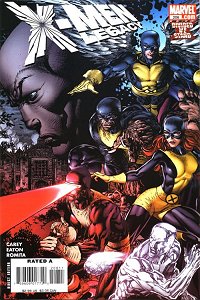 Though not a new title, per se, a new series debuted in April 2008 when X-Men (2nd series) changed names, becoming “X-Men Legacy” with #208. In the final battle of the Messiah Complex storyline, Professor Xavier had been shot in the head by Bishop. Now reanimated by Acolyte technology, Xavier struggled with piecing back together his memories… and thus his past.
Though not a new title, per se, a new series debuted in April 2008 when X-Men (2nd series) changed names, becoming “X-Men Legacy” with #208. In the final battle of the Messiah Complex storyline, Professor Xavier had been shot in the head by Bishop. Now reanimated by Acolyte technology, Xavier struggled with piecing back together his memories… and thus his past.
Xavier did not remain center stage in the series forever, though. By #222, the title's focus changed to Rogue, who became the series main protagonist during the remainder of its run. Though the series participated in most of the X-title crossovers, such as Necrosha, Second Coming and Age of X, the series explored Rogue's life and her ramifications of her recent mastery of her own powers. It also broke new ground with Xavier's son, Legion, helping him master his own pysche as well as his own powers. The series was also responsible for returning to Earth several X-Men that had been in deep space among the Shi-ar since the 2006 "Rise and Fall of the Shi'ar Empire" storyline from 2006.
X-Men Legacy was actually the first series to bear that name. When it was canceled in late 2012 at #275, it was replaced a few months later by another title of the same name, which focused on Legion.
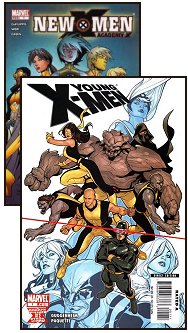 Like X-Men becoming X-Men: Legacy, so too did the Messiah Complex change New X-Men. However, instead of a simple title change, the title of New X-Men (2nd series) was canceled, its last issue being part of the crossover. The next month in April 2008, the title was replaced by Young X-Men. From the old cast of New X-Men, the “young X-Men” included Blindfold, Dust, Rockslide and Wolf Cub, to which over the series the new characters of Ink, Cipher and Graymalkin would be added. In addition to this, Anole, Mirage and Sunspot would join. Despite the relaunch, the new series quickly received poor reviews and was canceled with #12 in mid-2009 to be replaced with a third New Mutants series later that year.
Like X-Men becoming X-Men: Legacy, so too did the Messiah Complex change New X-Men. However, instead of a simple title change, the title of New X-Men (2nd series) was canceled, its last issue being part of the crossover. The next month in April 2008, the title was replaced by Young X-Men. From the old cast of New X-Men, the “young X-Men” included Blindfold, Dust, Rockslide and Wolf Cub, to which over the series the new characters of Ink, Cipher and Graymalkin would be added. In addition to this, Anole, Mirage and Sunspot would join. Despite the relaunch, the new series quickly received poor reviews and was canceled with #12 in mid-2009 to be replaced with a third New Mutants series later that year.
Meanwhile, though not relaunched as new titles, both other main X-Men titles, Uncanny X-Men & Astonishing X-Men, were treated to major changes. Abandoning their historic base of operations on the Xavier estate in Westchester, New York, the X-Men relocated to San Francisco, California, where they were welcomed by the general populace, as well as local law enforcement. It was right around this time that Uncanny X-Men (1st series) reached its landmark 500th issue.
At first, the X-Men attempted to integrate themselves in the Marin Headlands outside of the bay city, where they founded Greymalkin Industries. However, events conspired against them when Norman Osborn rose to power after the events of the Secret Invasion crossover. Seeing the X-Men as a literal X-factor that he could not control, Osborn took advantage of a small but vocal anti-mutant sentiment sweeping across the state and attempted to use his "Dark Avengers" to bring the X-Men to heel. A man with a plan, Cyclops enacted a daring gambit which resulted in the raising of a piece of Magneto's downed Asteroid M, creating an island in San Francisco bay. Naming it Utopia Island, after which the ensueing Utopia crossover was named, Cyclops declared it an independent nation and a haven for all mutants. Seeing the X-Men sequestered, Osborn declared vistory and left the X-Men alone.
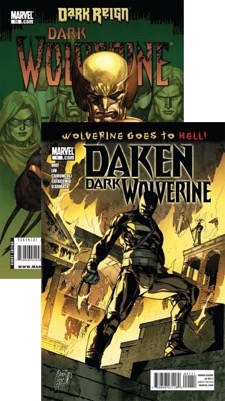 Out of the event, Wolverine main title went through a transition. As of #75 in August 2009, Wolverine (3rd series) became Dark Wolverine and focused on Daken, Wolverine's son and one of Osborn's Dark Avengers. The series turned out to have been an audition of sorts for Daken as the series concluded with #90 in October 2010, replaced the following month by Daken: Dark Wolverine, which lasted for 23 issues. The series ended with Daken's apparent death though even Wolverine doubted that his son was really gone. Though Daken took over his father's series, Wolverine was not to be without his own book. In addition to his Wolverine Origins series which was running at this time, Wolverine enjoyed a new series, Wolverine: Weapon X, which lasted for 16 issues.
Out of the event, Wolverine main title went through a transition. As of #75 in August 2009, Wolverine (3rd series) became Dark Wolverine and focused on Daken, Wolverine's son and one of Osborn's Dark Avengers. The series turned out to have been an audition of sorts for Daken as the series concluded with #90 in October 2010, replaced the following month by Daken: Dark Wolverine, which lasted for 23 issues. The series ended with Daken's apparent death though even Wolverine doubted that his son was really gone. Though Daken took over his father's series, Wolverine was not to be without his own book. In addition to his Wolverine Origins series which was running at this time, Wolverine enjoyed a new series, Wolverine: Weapon X, which lasted for 16 issues.
Another new series to come out of the Messiah Complex series was the new Cable ongoing series, this being his second. To continue the story of Cable’s task of raising the young girl, the new series, launched in April 2008, replaced the canceled Cable/Deadpool series which ended the month before with #50. In his new series, Cable traveled through time, fleeing from era to era, while attempting simultaneously to raise the mutant girl and avoid the pursuing Bishop. Unlike most series, which are published on a sliding timscale, the Cable series was published on an accelerated one, allowing readers to see Hope grow from a young infant to a young girl to a young woman in her late teens.
During the series' 25 issue run, Cable and Hope were mostly on their own, but did interact with Wolverine's new X-Force during the Messiah War crossover. The series ended with Cable intending to return back to the present and seek help from the X-Men, leading into the Second Coming crossover.
A little over six months after the cancelation of the Cable/Deadpool series (from which the new Cable ongoing was launched), so too did Deadpool receive his own, new, ongoing series. Like his previous series, this Deadpool series has utilized black-humor and the breaking of the fourth wall. The title ran for 63 issues, ending in late 2012. During the series' run, Deadpool also had several other, short ongoing series, such as Deadpool Corps and Deadpool Team-Up. The latter was notable for having started with #900 and began to work backwards in numbering.
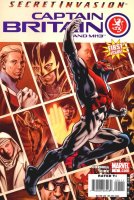 In July 2008, another Excalibur-based title was launched, this one trying a new approach in which the series focused mainly on Captain Britain, as noted from its new title: Captain Britain & MI:13. The MI:13 aspect of the title came from a fictional department of Britain’s Military Intelligence organization (the number 13 being skipped in their numbering system). Drawing from previous organizations depicted in the UK-centered Marvel stories in Excalibur, X-Force, New Excalibur & Wisdom series & miniseries, MI:13 was chartered with protecting the nation from supernatural threats. This was shown in the first storyline, in which Captain Britain attempted to foil the schemes of the Skrulls, as seen in the simultaneously published Secret Invasion miniseries, from obtaining Britain’s magical resources. Captain Britain and his team also faced against a resurrected Dracula, who had set up a base of vampires on the moon. Though it received high reviews, the new Captain Britain series was not very successful and ended with #15 in 2009.
In July 2008, another Excalibur-based title was launched, this one trying a new approach in which the series focused mainly on Captain Britain, as noted from its new title: Captain Britain & MI:13. The MI:13 aspect of the title came from a fictional department of Britain’s Military Intelligence organization (the number 13 being skipped in their numbering system). Drawing from previous organizations depicted in the UK-centered Marvel stories in Excalibur, X-Force, New Excalibur & Wisdom series & miniseries, MI:13 was chartered with protecting the nation from supernatural threats. This was shown in the first storyline, in which Captain Britain attempted to foil the schemes of the Skrulls, as seen in the simultaneously published Secret Invasion miniseries, from obtaining Britain’s magical resources. Captain Britain and his team also faced against a resurrected Dracula, who had set up a base of vampires on the moon. Though it received high reviews, the new Captain Britain series was not very successful and ended with #15 in 2009.

